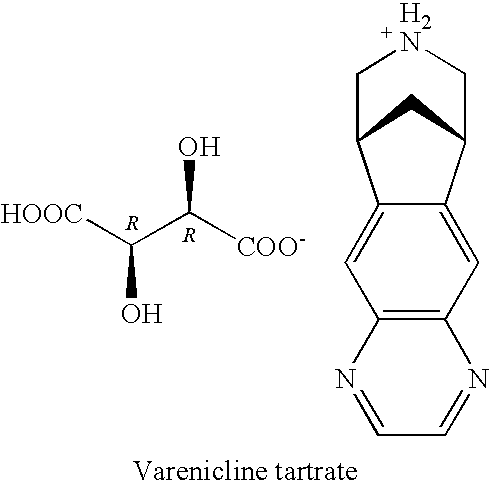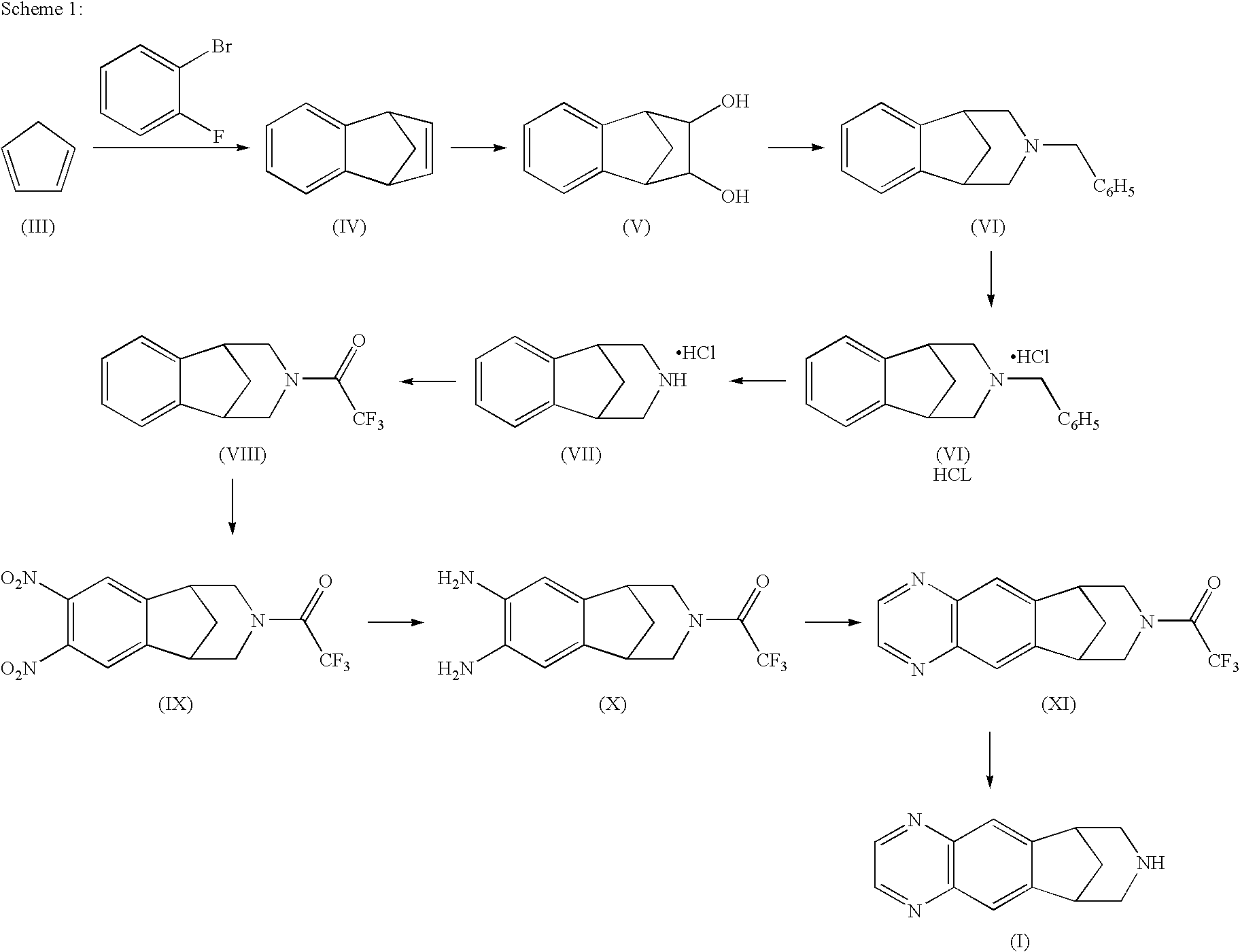Processes for the preparation of varenicline and intermediates thereof
- Summary
- Abstract
- Description
- Claims
- Application Information
AI Technical Summary
Benefits of technology
Problems solved by technology
Method used
Image
Examples
example 1
Preparation of 1,4-Dihydro-1,4-methano-napthalene (IV)
[0110]Magnesium turnings (85.1 g) and few iodine crystals were stirred under a nitrogen atmosphere in anhydrous THF (482.5 ml) in a clean, dry round bottomed flask with an addition funnel. The reaction mass was stirred and warmed to reflux (i.e., 60° to 65° C.) by a removable heating mantle. To this, 1-Bromo-2-fluoro benzene (21.2 gm) was added, followed by 1,2-dibromoethane (3.86 ml) to initiate the Grignard reaction. The heating source was removed, and reflux was maintained by the addition of mixture of 1-Bromo-2-fluoro benzene (500 g) and cyclopentadiene (193 g) (Mixture temperature 0° to 5° C.) within 2.5 to 3.5 hours. Reflux temperature was maintained for 2.5 hours. Progress of reaction was monitored by HPLC. The reaction mass was quenched in ice chilled water, and charged with concentrated HCl to obtain a clear solution. The product was extracted with hexane (500 ml×1, 482.5 ml×4). The combined organic layer was washed with...
example 2
Procedure for Preparation of 1,2,3,4-Tetrahydro-1,4-methano-napthalene-2,3-diol (V)
[0111]In a 1 l 4-neck round bottom flask equipped with mechanical stirrer was placed N-methyl morpholine N-oxide (401.9 g) and 1,4-dihydro-1,4-Methanonaphtalen-9-ylidene (414.0 g) in acetone (828 ml) and water (105 ml) at 25° to 30° C. To this mixture was added 15 mole percent solution of osmium tetroxide (1.0 g) in n-butanol (26 ml) at 25° to 30° C. The reaction mixture was stirred at reflux temperature, i.e., 65° to 70° C. for 2 hours. Progress of reaction monitored by HPLC. Distilled out reaction mixture under vacuum below 80° C., charged acetone (1035 ml) into the crude product, and stirred for 1.0 hour at 25° to 30° C. The reaction mass was filtered and washed with acetone (620 ml). The product was air dried to obtain a first crop of 1,2,3,4-Tetrahydro-1,4-methano-napthalene-2,3-diol (412.38 g, HPLC purity 99.85 percent.).
example 3
Procedure for Preparation of 1,2,3,4-Tetrahydro-1,4-methano-napthalene-2,3-diol (V)
[0112]In a 1 l 4-neck round bottom flask equipped with mechanical stirrer was placed N-methyl morpholine N-oxide (521.35 g) and 1,4-dihydro-1,4-methanonaphtalen-9-ylidene (537.0 g) in the mother liquor of the previous reaction (2000 ml) water (70 ml) at 250 to 30° C. Approximately 1000 ml of acetone was distilled out at 65° to 70° C. The reaction mixture was stirred at reflux temperature, i.e., 65° to 70° C. for 3 hours. Progress of reaction monitored by HPLC. The reaction mixture was distilled out under vacuum below 80° C. The crude product was charged with acetone (1074 ml), and stirred for 1.0 hour at 25° to 30° C. The reaction mass was filtered and washed with acetone (805 ml), and the product was air dried to obtain a first crop of 1,2,3,4-Tetrahydro-1,4-methano-napthalene-2,3-diol (552.0 g, HPLC purity 99.94 percent). The mother liquor was concentrated to provide a semi-solid that was then tritu...
PUM
 Login to View More
Login to View More Abstract
Description
Claims
Application Information
 Login to View More
Login to View More - R&D
- Intellectual Property
- Life Sciences
- Materials
- Tech Scout
- Unparalleled Data Quality
- Higher Quality Content
- 60% Fewer Hallucinations
Browse by: Latest US Patents, China's latest patents, Technical Efficacy Thesaurus, Application Domain, Technology Topic, Popular Technical Reports.
© 2025 PatSnap. All rights reserved.Legal|Privacy policy|Modern Slavery Act Transparency Statement|Sitemap|About US| Contact US: help@patsnap.com



